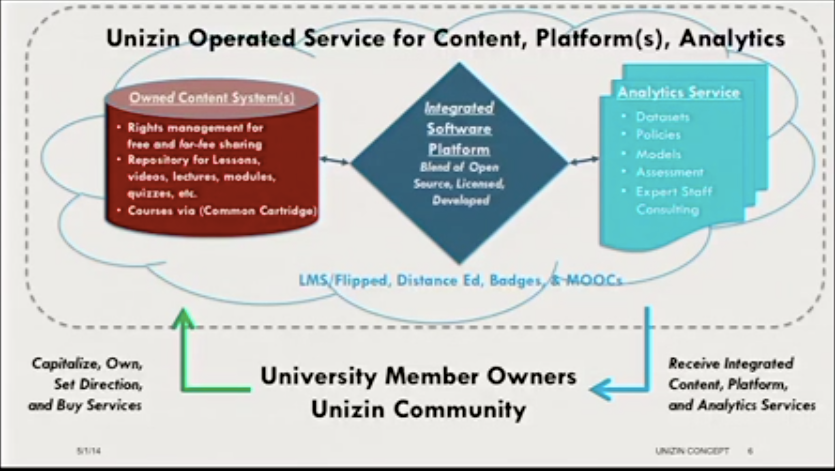In Michael’s most recent post on Unizin, the new “learning ecosystem” initiative driven by Indiana University, he asked the question of who would be threatened by the proposed consortium (with the answer of edX). This question assumes of course that Unizin actually succeeds in large part, but what are the primary risks for the initiative to succeed in the first place? Based on the public information we have available to date (primarily in the two posts linked above), I see two near-term risks and one long-term risk that rise above the others.
Near-Term Risk: Getting Schools to Sign Up
The obvious question is whether there are enough schools willing to commit $1 million and adopt the proposed platforms to get the consortium off the ground. Based on the Colorado State University recording, it appears that the goal is to get 9 – 10 schools to commit $9 – $10 million in the initial phase. Beyond Indiana University, the most likely school to commit is the University of Michigan. Their leadership (dean of libraries, CIO) are fully behind the initiative, and from press reports they are seeking final approval. I cannot find any evidence that any other schools have reached this point, however.

There are active debates in the Committee on Institutional Cooperation (CIC), primarily between provosts and CIOs, about Unizin and whether this approach works for member institutions. The provosts in fact already put out a position paper generally endorsing the same concept.
While new and cost effective technological capabilities make certain changes in higher education possible, it does not necessarily follow that such changes are desirable, or would be endorsed or utilized by our existing students, faculty, or community members. Nor does it mean that we fully grasp the costs and business models that might surround new strategies for broadly disseminating course content. University leaders committed to addressing the new opportunities in higher education need to recognize that the primary basis for motivating and inspiring faculty to engage these opportunities will not be the technologies themselves, but rather, the fundamental academic values and pedagogical principles that need to be infused in these emerging instructional technologies. For these reasons, we believe that the chief academic officers of our CIC member universities are in the best position—individually and collectively—to be leading these efforts.
Putting out a position paper is not the same as getting buy-in from a campus or contributing real money, and I suspect that most of the potential campuses will need some form of this discussion before signing up.
Near-Term Risk: Secretive decision process
On the subject of campus buy-in, the actual secretive process that is being pursued by Unizin and prospective schools is itself a significant risk, especially in the post MOOC-hype environment. Institutions are considering this major investment and commitment in a deliberately opaque process. Provosts, CIOs and occasionally faculty groups are being briefed, but almost all documentation is being hidden. During the Colorado State University meeting, one faculty member asked about this process:
At the recorded CSU meeting, one of the presenters—it’s impossible to tell which is the speaker from the recording we have—acknowledges that the meetings were largely conducted in secret when challenged by a faculty member on the lack of faculty involvement. He cited sensitive negotiations among the ten universities and Instructure as the reason.
These same questions are being raised about the decision processes behind many of the MOOC adoptions. Consider the University of Texas, which committed $5 million to their involvement in edX. The Daily Texan has publicly started a debate on that campus about the motivation and benefits of that decision.
The MOOCs were, apparently, designed without revenue in mind, though the System invested $10 million to both develop the MOOCs and to host the courses on edX, an online platform created by Harvard and MIT. [snip]
Of course, the System has made large and unproven investments in online education platforms before — MyEdu rings a bell. The Tribune recently reported that the System will see no financial return on its $10 million investment in MyEdu, which was ultimately sold to Blackboard. Again, there was no long-term financial plan in mind, but there was a lot of money on the table.
The System should stop investing millions of dollars on gambles like these, which lack financial exit strategies and viable forms of revenue. If the founding structure of a project doesn’t include a business model for growth and profitability for the University, who is expected to fund it?
Now UT is considering another seven-figure investment in a very closed process. If they join, UT could face pushback from faculty on campus based on any decision to join Unizin, partially reaping what edX sowed.
Faculty groups nationwide are concerned about administrative decision-making that directly impacts academics without directly and transparently involving broad faculty input. Unizin involves not only an LMS adoption but also learning content repository and learning analytics platform. This gets the difficult questions of how and whether to share learning content as well as measuring learning outcomes. Faculty will care.
And there is a hint of a typical university conflict embedded at the end of the CIC provosts’ position paper quote – “we believe that the chief academic officers of our CIC member universities are in the best position … to be leading these efforts”, perhaps with the unwritten phrase “as opposed to CIOs”.
It used to be that CIOs and their organizations would make most technology platform decisions, and quite often it was hard to get the provost office to participate. As can be seen in this statement, we now have situations where provosts and their offices want to be the driving force even for platform decisions. Ideally, the better approach is collaborative where the provosts and CIOs work together, generally with provosts taking a more active role in defining needs or problems and CIOs taking a more active role defining solutions.
In the Unizin content repository case, what would be more natural is for the provosts to first help define what learning content should be shared – learning objects, courseware, courses, textbooks – and under what conditions. After defining goals it would be appropriate to describe how a software platform would facilitate this content sharing, with CIOs taking a more active role in determining whether certain scenarios are feasible and which platforms are the best fit. Throughout the process faculty would ideally have the opportunity to give input on needs, to give feedback on proposed solutions, and to have visibility in the decision process.
Whether this type of open, collaborative decision process is happening behind closed doors is not known, but the apparent need to keep the process quiet raises the risk of pushback on the consortium decision.
Long-Term Risk: Development of Content Repository and Learning Analytics
Even if Unizin succeeds in getting 9 – 10 schools to fund and start the consortium, and even if they successfully manage the faculty buy-in aspects, there is a longer-term risk on making the “learning ecosystem” a reality. Currently the three primary components are very uneven. The LMS is a no-brainer as Canvas already exists and already has broad acceptance as the most popular LMS on the market in terms of recent LMS evaluations and new adoptions. The two other components are very different and might not be well-suited for a community-source development model.
The ed tech road is littered with unsuccessful and disappointing content repositories. The concept of making it easy to share learning content outside of a specific program has long looked beautiful in white papers and conference briefings, but the reality of actual adoption and usage is quite different. Whether the challenge is product design, product completion, or just plain faculty adoption, there are no indications that there is a demand for broad-based sharing of academic content. In essence, the product category is unproven, and it is not clear that we even know what to build in the first place.
Community source has proven its ability to develop viable solutions for known product categories and generally based on existing solutions – consider Sakai as an LMS (heavily based on U Michigan’s CHEF implementation and to a lesser degree on Indiana University’s OnCourse), Kuali Financial System (based directly on IU’s financial system), and Kuali Coeus (based on MIT’s research administration system). When you get rid of a pre-existing solution, the results are less promising. Kuali Student, based on a known product category but designed from the ground up, is currently on track to take almost 8 years from concept to full functionality. Looking further, are there any examples where a new product in an ill-defined product category has successfully been developed in a community source model?
Learning analytics is similar to content repositories in the sense that the concept looks much better in a whitepaper than it does in reality. I remember in the late 2000s when the LMS user conferences came across as ‘we’re learning outcomes companies that happen to have an LMS also’. Remember Blackboard Outcomes System – its “most significant product offering”?
The difference between learning analytics and content repositories, however, is that there are much stronger examples of real adoption on the analytics side. Purdue has successfully implemented Course Signals and has succeeded in improve course retention (despite the challenge of whether inter-course retention has improved). Blackboard Analytics (based on the iStrategy acquisition) has been implemented with real results at a growing number of schools.
More significantly, perhaps, is the work done by the Predictive Analytics Framework (PAR), which just today announced that it was becoming a separate organization spun off by WICHE. The Unizin slides explicitly reference PAR, and some of the analytics language closely mirrors PAR descriptions. The reason this is significant is that the PAR framework goes a long way towards helping to define the product needs.
The question for analytics, therefore, is less on the product category and more on the ability of Unizin to deliver actual results.
If Unizin succeeds in addressing the above risks, then the state of art for learning ecosystems will jump forward. If the proposed consortium does not succeed, the result will be a buyer’s club that makes Canvas a very expensive LMS. That result would be ironic, given some of the foundational concepts behind Unizin.

Hi Mike/Phil
If one looks at PAR, it is driven by analytics that are past looking. What if the problem is not the students (totally) but the possibility that the current HEI frame is wrong. That means the efforts based on PAR are useful if students are to succeed in the historic frame.
Yet, everyone says we are in a period of disruption where alternative paths for knowledge acquisition are present and accepted (one of the fears is that students will come to the traditional university w/sufficient “credits” to pass beyond the freshman/sophomore institutional cash cows).
I would bet some of the institutions thinking about EdX see that, as MIT has stated, new models will emerge. And MIT’s risk capital has been rewarded, not just in technology but also in K-16+ education (think their media lab as an example). Unizen has some of these same elements.
Education, by its very nature, is a lagging indicator. It would be important to understand what the upside is if both EdX and Unizen succeed. If Clayton Christensen’s insights have any weight, and I were a traditional academic institution, I might be very interested in what that success might mean and how I might need to respond, PAR’s analytics not withstanding.
Tom, you have a good point about past-looking data (even though the intent is to predict future performance), but remember the source of Unizin is a core of traditional universities that, as far as I can tell, do not want to seek out new models. They want to enhance their current models. The Unizin learning ecosystem seeks to innovate within that constrained space, slightly expanded to included edX-style MOOCs.